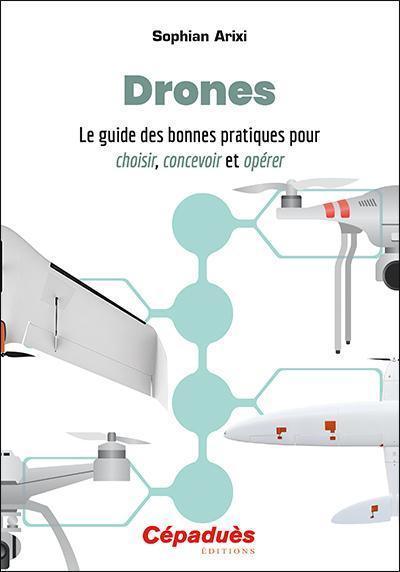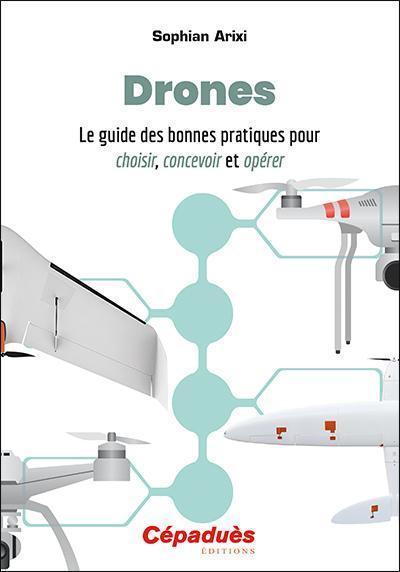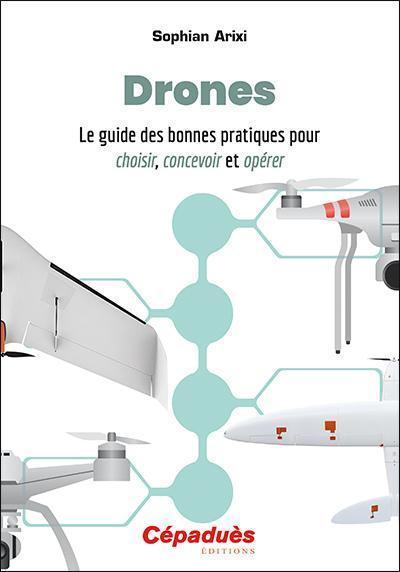UAVS - THE GUIDE TO GOOD PRACTICE IN SELECTING, DESIGNING AND OPERATING UAVS
For a professional, ensuring the success of a project means choosing the right drone among dozens of possible types of machines, the drone that will allow you to carry it out. Only one machine will have to stand out from the crowd, answering the many questions you need to ask yourself:
What are the different types of drones and their uses?
Is it better to build your own drone or to buy one ready to fly?
What are the elements of the drone that will allow you to make the right choice?
How to choose your batteries?
What are the criteria for choosing an autopilot?
A UAV is only an airborne vector carrying the payload and perfecting this symbiosis between the project and the machine, also imposes its share of questions to be solved such as: How to design its payload?
What are the impacts of the payload on the choice of the UAV and on the flight path?
Finally, the place of operation also has its constraints:
What are the precautions to be taken to operate in the field?
What organisation should be adopted?
How should the radio link be sized to avoid a communication breakdown?
What are the choices to be made among the different launch and recovery systems?
This book will accompany you in order to bring your answer, and to know how to organize yourself to implement it.
Table of Contents
Acknowledgements
Disclaimer
Chapter 1: Choosing the right UAV, the key to your success
1.1. Fixed wing or tournante ?
1.1.1. The take-off and landing place
1.1.2. The type of flight
1.1.3. The payload
1.2. In kit form or " prêt to voler " ?
Chapter 2: The choice of custom-made - do-it-yourself UAVs
2.1. Specificities for the choice of a fixed wing
2.1.1. The fuselage
2.1.2. The wings
2.1.3. The stabilizer
2.1.4. The landing gear
2.1.5. Power train
2.1.6. Vertical Take-Off and Landing (VTOL) and others
2.2. Specificities of a rotating wing
2.2.1. The choice of the chassis
2.2.2. The choice of the motorization
2.3. Autopilots
2.3.1. Hardware criteria
2.3.2. Firmware criteria
2.3.3. Ground station criteria
2.3.4. But also
2.3.5. Firmware and hardware : Open source or pas ?
2.3.6. First steps on Ardupilot
2.4. Cables and connectors
2.4.1. Signal connections
2.4.2. Power connections
2.5. GPS
2.6. Servomotors
2.7. Batteries
2.8. Safety systems
2.9. Ground - UAV links
2.10. Designing its payload
2.10.1. Design
2.10.2. Assembly
2.10.3. Integration
2.11. 3D impressions
Chapter 3: Operating in the field
3.1. Regulations
3.2. Tools and common equipment
3.3. Getting organized on site
3.3.1. Pre-visit the field of operation
3.3.2. Maintenance
3.3.3. Essential checks before flying
3.3.4. Launch systems
3.3.5. UAV recovery systems
Chapter 4: Civilian users from all walks of life
4.1. Audiovisual
4.2. Building and construction
4.3. Scientific research
4.4. Precision agriculture
4.5. Surveillance and security
Conclusion
Bibliography
DRONES - LE GUIDE DES BONNES PRATIQUES POUR CHOISIR, CONCEVOIR ET OPÉRER est en rupture de stock et sera expédié dès qu’il sera de retour en stock.
Informations complémentaires
Informations complémentaires
Livraison et retour
Livraison et retour
La Boutique du Pilote vous offre une livraison Gratuite* (*0.01€, réservé au livraisons en France métropolitaine) dès 250€ d'achats avec l'option "COLISSIMO 48H".
Zone de livraison:
Les produits sont expédiés à (aux) l'adresse(s) de livraison que le CLIENT aura indiquée(s) au cours du processus de commande. En cas de livraison hors de la zone Europe ou dans les DOM/TOM, le CLIENT devra s’acquitter de tous les frais liés à l’importation dans le pays de livraison.
Délai d’expédition:
Les délais pour préparer une commande puis établir la facture, avant expédition des PRODUITS en stock sont mentionnés sur le SITE. Ces délais s’entendent hors weekends ou jours fériés. Un message électronique sera automatiquement adressé au CLIENT au moment de l’expédition des PRODUITS, à condition que l’adresse électronique figurant dans le formulaire d’inscription soit correcte.
Délais & Frais de livraison
Au cours du processus de commande, Le VENDEUR indique au CLIENT les délais et formules d'expédition possibles pour les PRODUITS achetés. Les coûts d'expédition sont calculés en fonction du mode de livraison. Le montant de ces coûts sera dû par le CLIENT en sus du prix des PRODUITS achetés. Le détail des délais et frais de livraison est détaillé sur le SITE. A défaut d’indication ou d’accord quant à la date de livraison, le VENDEUR livre le PRODUIT sans retard injustifié et au plus tard trente (30) jours après la conclusion du contrat. (Article L.216-1 du Code de la consommation).
Modalités de livraison
Le colis sera remis au CLIENT contre signature et sur présentation d'une pièce d'identité. En cas d'absence, un avis de passage sera laissé au CLIENT, afin de lui permettre d'aller chercher son colis dans son bureau de poste.
Paiement sécurisé
Vos informations de paiement sont traitées de manière sécurisée. Nous ne stockons pas les détails de votre carte de crédit et n'avons pas accès aux informations de votre carte de crédit.





